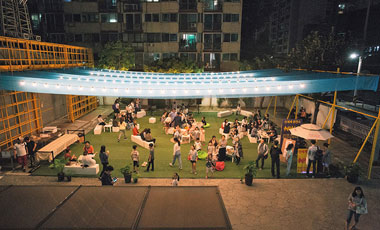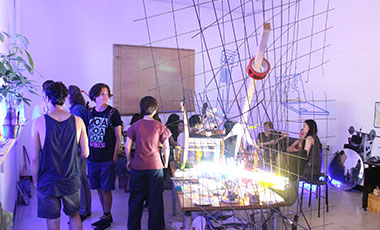Features / Focus
Hyunjin Kim: Artistic Director of the Korean Pavilion at Venice Biennale 2019
posted 09 April 2019Hyunjin Kim was born in 1975. She received her bachelor of arts degree from the Department of Art Studies at Hongik University and earned her master’s degree from the same university’s graduate school. She completed a post-graduate program in Critical Studies at the Malmö Art Academy of Lund University in Lund, Sweden. She has worked as a curator for Alt Space Loop(1999) and a co-curator of the 7th Gwangju Biennale(2006). She also served as the Director of the Arko Art Center(2014–2015). At present, Kim works for Kadist in San Francisco as the lead regional curator for Asia. Major exhibitions she has curated include 《30, Sa-dong》(Sa-dong, Incheon, 2007), 《Ten Years, Please – A Project by Jewyo Rhii》(Gallery 27, 2007), 《Tradition (Un)Realized》(Arko Art Center, 2014), and 《2 or 3 Tigers》(Haus der Kulturen der Welt, Berlin, 2017).
Hyunjin Kim, Artistic Director of the Korean Pavilion at Venice Biennale 2019. Photoⓒ Park Hongsoon
Experimentation over stability, corner over core
The 58th edition of the Venice Biennale, the oldest and most prestigious exhibition of its kind, is due to open shortly on May 11. This year’s Korean Pavilion will feature the work of Hwayeon Nam, siren eun young jung, and Jane Jin Kaisen under the direction of Hyunjin Kim, an independent curator, and art critic. With only a hundred days remaining before the opening of the event, I sat down with the Korean Pavilion’s art director Hyunjin Kim to hear her talk about its design and this year’s theme “women and gender-diversified narratives that interrupt, break away from, and reconstruct previous understandings of modernization in the region of East Asia,” and also the work of the three women artists brought together under this theme.
The interview began with my belated congratulations on her selection as the artistic director, which was already announced in June last year. I then asked her how it felt to be selected to manage such a high-profile project. Kim thanked me, saying, “People have been showing great interest and support for this project from the early stage on, probably because the Venice Biennale is a prestigious international exhibition much more widely known than the exhibitions I have curated thus far. So, it is really great to work in such a supportive atmosphere. I am delighted.”
Women are in complete charge of this year’s Korean Pavilion. Not only is it curated by a woman, but all the three artists whose work will be shown there are also women. It is made thoroughly clear that the theme proposed by Kim—“Women and gender-diversified narratives that interrupt, break away from, and reconstruct previous understandings of modernization in the region of East Asia”—is not a mere coincidence. Kim has long been interested in casting light on the other side of history—in other words, the other side of the West/male-centered narrative maintained in patriarchal Asian societies, from a gender perspective. Although she has previously undertaken a number of projects reflecting a critical gender consciousness, this is her first project wherein “women and queers” are at the forefront as its central focus, she says.
Hyunjin Kim (left in the photo) and Anselm Franke, co-curators of 《2 or 3 Tigers》 held in 2017, in the Haus der Kulturen der Welt (HKW).
Since the curation of 《Brilliant Collaborators》 and 《Animism》 in 2013, two exhibitions in the Ilmin Museum of Art, Kim has continuously worked on research-based projects that produce knowledge. By focusing on “modernity” and the “modernization in Asia,” she has endeavored to rediscover traditional languages that can free our perception from concepts that became “invented traditions” or bring to light the diversity of Asian modernity in exhibitions she curates as well as in her research. Meanwhile, her decision to approach Asian history from the viewpoint of women artists in the Korean Pavilion project was directly inspired by her experience working on 《2 or 3 Tigers》 she co-curated with Anselm Franke (2017, HKW). “For Anselm Franke and me, there was a criterion that was just as important as the type of works to be shown, which was ‘gender balance.’ Gender imbalance is still a problem not just in Asia, but worldwide. The proportional representation of women in an exhibition setting has long since become an absolutely essential ethical and political priority for any curators working in an international environment. My goal was to show the work of women artists who are no lesser in terms of weight and presence than male artists who work on themes related to Asian history, such as Ho Tzu Nyen or PARK Chan-Kyong,” she confides. She further clarified her curatorial intent in the Korean Pavilion project, saying, “Working with artists with a solid international standing would probably draw more attention. But, I felt that it was more meaningful to turn this exhibition into an opportunity for talented women artists of my generation with a keen historical consciousness to grow, both in quantity and quality.”
Exhibition view of 《2 or 3 Tigers》, Artists LIM Minouk and Lieko Shiga setting up their works.
The interview that lasted nearly 90 minutes concluded with this final remark from Kim, “Art exists everywhere and anywhere.” This remark struck me in a very special way—in fact, much more than all other equally interesting things that were said during this conversation. I, like many art watchers, am impatient to discover what kind of harmony this curator, who is never afraid of getting out of her comfort zone to experiment and explore new horizons, will create with the work of three women artists, Hwayeon Nam, siren eun young jung, and Jane Jin Kaisen, and how this will challenge our mind.

※ This content was first published in the February, 2019 release of Wolganmisool Magazine and has been re-published on TheARTRO.kr after a negotiation was reached between Korea Arts Management Service and Wolganmisool Magazine.
Se Weon Gwak
Editor, Art Magazine [Wolganmisool]


